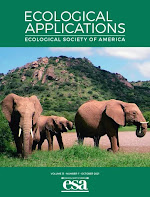Üdvözlöm gyepek helyreállításával és gyepi biodiverzitás kutatásával foglalkozó blogomon! A blogon rendszeresen hírt adok a DE TTK Ökológiai Tanszék, az MTA-DE Biodiverzitás kutatócsoport és az MTA-DE Lendület Funkcionális és Restaurációs Ökológiai Kutatócsoport munkatársaival végzett kutatásaimról illetve aktuális eseményekről és konferenciákról.
2021. október 30., szombat
Véleménycikk a globális faültetés kapcsán a Restoration Ecology-ban
Urgent need for updating the slogan of global climate actions from ‘tree planting’ to ‘restore native vegetation’
Tölgyesi Csaba, Elise Buisson, Aveliina Helm, Vicky M. Temperton, Török Péter
The prevailing nature-based solution to tackle climate change is tree planting. However, there is growing evidence that it has serious contraindications in many regions. The main shortcoming of global tree planting is its awareness disparity to alternative ecosystem types, mainly grasslands. Grasslands, where they constitute the natural vegetation, may support higher biodiversity and a safer, soil-locked carbon stock than plantation and other forests. We suggest replacing ‘tree planting’ by ‘restore natural vegetation’. This improved action terminology reduces the risks of inappropriate afforestation and, by diversifying target ecosystem types, does not reduce but increases potential land area for nature-based climate mitigation.
2021. október 17., vasárnap
Új cikkünk a Journal of Applied Ecology-ban
2021. október 14., csütörtök
Új cikkünk a Functional Ecology-ban
Patterns of pollination interactions at the community level are related to the type and quantity of floral resources
Edy Fantinato, Judit Sonkoly, Péter Török, Gabriella Buffa
A fundamental question in community ecology is how the quantity of floral resources affects pollinator activity and how this relates to the structure and robustness of pollination networks. The issue has been mainly addressed at the species level, while at the community level several questions are still open.
Using a species-rich semi-natural grassland as model ecosystem, we explored the relationship between community-level quantity of floral resources, the number of flower visits at community level and descriptors of the structure and robustness of pollination networks. To assess whether patterns of pollination interactions were consistent when using different types of floral resources, we measured three types of floral resources, namely the volume of nectar, the number of pollen grains and the number of flowers.
Community-level pollinator visitation rate showed a hump-shaped relationship with the quantity of floral resources. Results were consistent among models employing different measures of floral resources as independent variables. The relationship between the quantity of floral resources and the structure and robustness of the network was not consistent among different types of floral resources; only intermediate levels of nectar volume were associated with high levels of network robustness.
The pattern we found is in contrast with some former studies which reported positive linear relationships between the community-level visitation rate of pollinators and the quantity of floral resources. Rather, the observed hump-shaped pattern resembles the relationship previously found between the quantity of floral resources of a given plant species and its visitation rate per flower. Our results highlighted that, by using specific types of floral resources (e.g. the volume of nectar and the number of pollen grains), it is possible to reveal ecological processes that would be masked by using the number of flowers as the sole measure of floral resource.
Új közleményünk az Ecological Applications szaklapban
Post-restoration grassland management overrides the effects of restoration methods in propagule-rich landscapes
Tölgyesi Csaba, Vadász Csaba, Kun Róbert, Csathó András István, Bátori Zoltán, Hábenczyus Alida, Erdős László, Török Péter
Grassland restoration is gaining momentum worldwide to tackle the loss of biodiversity and associated ecosystem services. Restoration methods and their effects on ecological community reassembly have been extensively studied across various grassland types, while the importance of post-restoration management has so far received less attention. Grassland management is an important surrogate for natural disturbances, which most ancient grasslands have co-evolved with. Thus, without the reintroduction of management-related disturbance, restoration targets are unlikely to be achieved in restored grasslands. In this study, we aimed to explore how 20 years of management by mowing once a year or light cattle grazing, affects restoration success in Palearctic meadow-steppe grasslands restored by either sowing native grasses (‘sown sites’), applying Medicago sativa as a nurse plant (‘Medicago sites’), or allowing spontaneous succession (‘spontaneous sites’). We found that following mowing, sown sites maintained long-lasting establishment limitation, while Medicago sites seemed to have experienced a delay in succession. These limitations resulted in low total and target species richness, low functional redundancy and distinct species and functional composition compared to reference data from ancient grasslands. Spontaneous sites that were mowed reached a more advanced successional stage, although they did not reach reference levels regarding most vegetation descriptors. Sown and Medicago sites that were grazed had higher total and target species richness than those that were mowed, and showed restoration success similar to that of spontaneous sites, on which grazing had only moderate further positive effects. Grazed sites, irrespective of the restoration method, were uniformly species rich, functionally diverse and functionally redundant, and thus became important biodiverse habitats with considerable resilience. We conclude that an optimally chosen post-restoration management may have an impact on long-term community reassembly comparable to the choice of restoration method. Restoration planners may, therefore, need to put more emphasis on future management than on the initial restoration method. However, our findings also imply that if local constraints, such as potentially high invasive propagule pressure, necessitate the application of restoration methods that could also hinder the establishment of target species, the long-term recovery of the grassland can still be ensured by wisely chosen post-restoration management.




